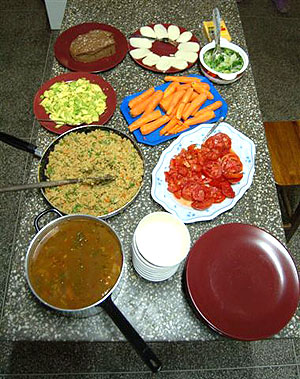At 6:45 A.M. Jen and Tracey left to follow Theresa Kapenda through her daily routine of feeding 100 plus children. Theresa is the older sister of Ignatius Kapenda, the father of the Living Compassion House and the Coordinator of Living Compassion in Zambia. She was born and raised in Kantolomba and resided there until this last year.
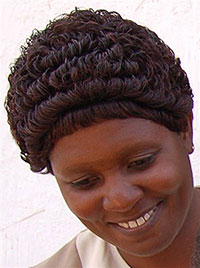
It is because of Theresa that this program exists at all. Last year on a visit to the compound by the Living Compassion Africa team she was asked, “If you could do one thing to make a difference in this community, what would you do?” She answered, “I would start a program to feed the most vulnerable children. I would use our old house as the place to cook.” The team exchanged an “Are we in agreement?” look and with a nod, gave Theresa an enthusiastic “YES!”
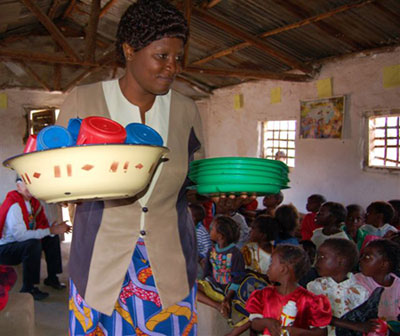
We were eager to video the process of feeding one hundred children, beginning with visiting the shops to purchase the ingredients while relying on local transportation, to walking the final distance from the mini-bus stop carrying all the supplies, to preparing the food in huge pots over open fires of charcoal–no electricity and no running water.
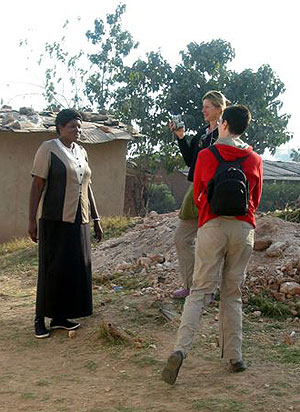
At 7:45 the rest of us made our way to Kantolomba to photograph the children as they did their lessons and had lunch. The lessons began with lively singing and as they went into “shapes” (identifying squares, circles, rectangles, and triangles), the teachers began to bring the children to the back of the room where they would stand on a bench and have their picture taken.
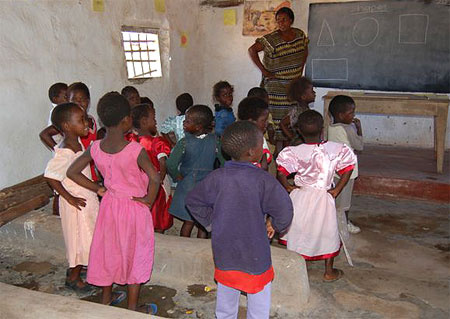
As Rebecca took each child’s picture, Alex would write down the name, age, and family status of each one. Children are either single orphans (mother or father has died), double orphans (both parents are dead), or vulnerable (they may have one or both parents but the family is so poor the children are not eating.) After Alex took down the information Rebecca would photograph his notes so we could be sure to have the right statistics for the right child. (Sorry, we were so busy snapping the kids that we neglected to get any photos of the photography team doing their work.)
The first group, the 3-5 year olds (59 in number) arrive at 8 AM and stay until 10 AM. The second group, the 6-8 year olds (48 in number) arrive at 10 and leave at noon. Considering there were one hundred and seven children the photography process went smoothly and we are very excited to have our first Kantolomba School yearbook.
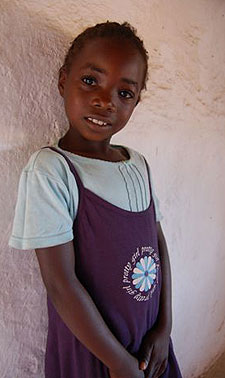
Mary, 7 years old, is a “double orphan” (both parents have died).
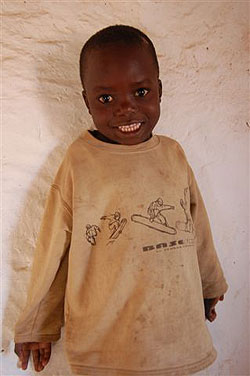
Kelvin, 5 years old, is a “single orphan” (his father died).
We did notice that there were more than the 100 children we thought we were feeding. We asked Theresa about the growing number, curious if she would send children away. She laughed saying, “No! How could I send them away? They would cry; they would lie on the ground and roll around!” Who could blame them? Who could blame her?
There are six to eight volunteers who meet Theresa each day at a house next door to the school. The women who own the house donate the use of their home to prepare the meals for the children. As the volunteers arrive they wash their hands and wrap their heads in chitenge to insure cleanliness. There is a weekly rotation of meals that includes rice and beans, soya chunks, nshima (mealie meal), bread and tea with sugar.
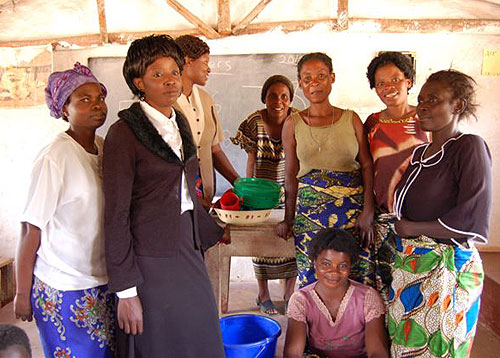
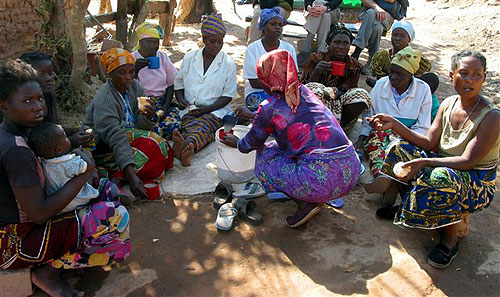
The cooking for the first shift of students begins at 8 AM with the lighting of the home-made charcoal in the outdoor cooker while others ferry jugs of water from the nearest spigot. Depending on the menu for the day the women spend the next hour or so preparing meals for the 3-5 year olds. At 9:30 they carry the food to the school. The children sit patiently on their hand-molded mud benches as the volunteers serve row by row.
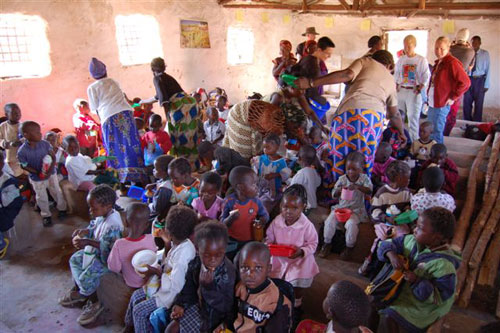
On this day the meal was tea and buns with butter. The team accompanying Theresa quickly noticed there was no nutrition in the day’s menu. Across from the bakery in the local open-air market they inquired about peanut butter and milk and found they could purchase these for all the children for $12. We realized this is a permanent commitment we need to make to their diet.
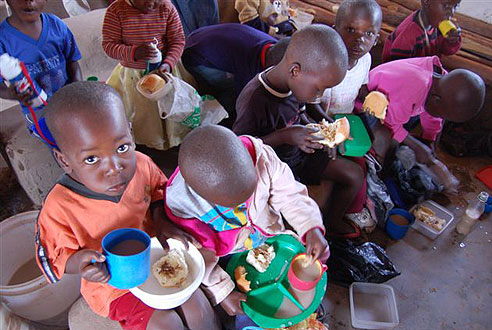
Knowing this was the first time most of the children had tasted peanut butter or milk we watched anxiously to see their response. When we saw them eating only small portions of their bun we asked Theresa if it was because they didn’t like the peanut butter. She explained, “No! They like it! That’s how they do it. They eat only a little and save the rest to share with hungry brothers and sisters at home.”
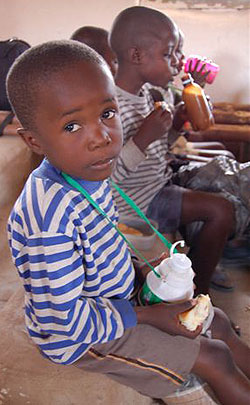
The children are asked to come to school with something to eat and drink from. A few have little backpacks but most carry their little plastic containers with lids and their plastic bottles for drinking in a plastic grocery store bag. We noticed how much those with the backpacks enjoyed opening and closing the zippers, arranging and rearranging the few possessions. We projected that having something to call their own must be very important in this chaotic world of deprivation. This has inspired us to commit to supplying a kid-size backpack with a 5X5 Tupperware container and a wide-mouth, screw-top plastic bottle for drinking for each child. The Bridge Walk would be an ideal time to donate one of these if you would like to join in. You could bring it to the walk (preferable) or send it to us if you won’t be able to be there. If you would like to add simple school supplies, a writing tablet and some pencils, that would be grand.
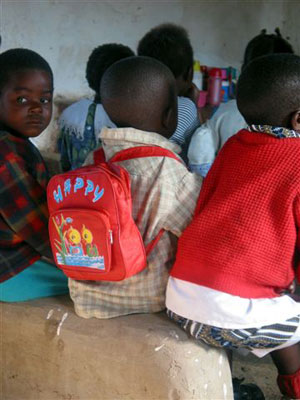
In the late afternoon we headquartered as usual at the Savoy and broke into teams each with a different mission—again, as usual. One team went in search of batting for Martin to use in placemats; Ignatius and Mr. Kayula drove off in search of Martin himself to collect the bags and placemats he’s sown for us so far. Still another team headed off for the hardware store to buy picks and shovels to be used to bury the new water line we are installing in Kantolomba. Those that remained at the Savoy worked with the sketchy internet connection there to communicate with the Monastery and others in the US and to get out the blog.
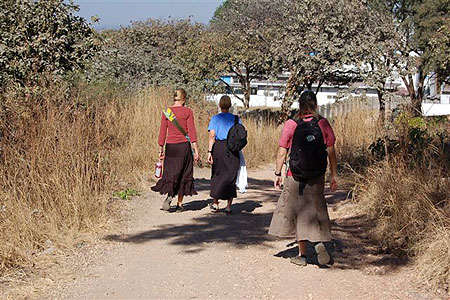
Back at the guesthouse while preparing our evening meal we made notes about the day. We find that if we wait 24 hours to write down all of the things we have accomplished we forget certain events and days seem to run together like molasses. Agness joined us for dinner–and more cake. As you can see from the picture we enjoyed yet another gourmet meal. As exhaustion settled over us we decided to make all the decisions about the next day over breakfast at O9 hours. (With all this great food we’re having a harder and harder time fitting nine or ten of us into the car.)
